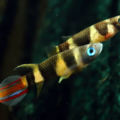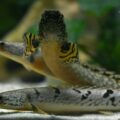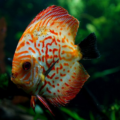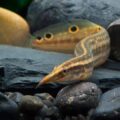Renowned for their slender, eel-like body and mesmerizing patterns, Kuhli Loaches, are one of the most fun bottom-dwelling freshwater fish. Stay tuned as we unravel the secrets of caring for Kuhli Loaches, from optimal tank conditions to much more.

Introduction:
Within the huge web of aquatic life, some species stand out for their distinctive traits and captivating behaviors. Among these intriguing creatures is the Kuhli Loach also referred to as eel loach, a slender and secretive fish that has attracted aquarium aficionados for many years.
Whether you’re a seasoned aquarist or a novice enthusiast, join us as we delve into the mysterious world of eel Loaches and uncover the secrets of these remarkable creatures.
Whether you’re a seasoned aquarist or a novice enthusiast, join us as we delve into the mysterious world of Kuhli Loaches and uncover the secrets of these remarkable creatures.
Characteristics:
The Kuhli Loach, often known as (Pangio kuhlii) is a thin and elongated fish with a unique appearance that sets it apart from other species. Its body is cylindrical and worm-like, adorned with a series of dark vertical stripes that run along its pale pink or yellowish-brown body. The eyes of loaches nestled with transparent skin, lend an intriguing aspect to their appearance.
These bands provide exceptional camouflage in their natural habitat, allowing Kuhli Loaches to fit in perfectly with their surroundings. With their eel-like shape and graceful movements accentuated with dorsal and anal fins, these loaches add a touch of elegance to any aquarium setting.
| Family | Pangio kuhlii |
| Common name | Kuhlii Loach |
| Origin | Freshwater rivers and streams of Southeast Asia, including Indonesia, Malaysia, Thailand, and Borneo |
| Size | Typically, 3 to 5 inches (7.5 to 12.5 centimeters) in length |
| Lifespan | 5 to 10 years in captivity |
| Water parameters | Soft substrates, plenty of hiding spots, stable water parameters (temperature: 75-82°F, pH: 6.0-7.5), gentle flow |
| Tank size | Minimum tank size of 20 gallons |
| Diet | Omnivorous scavengers, feeding on small invertebrates, algae, sinking pellets, and blanched vegetable |

Size:
Full-grown Kuhli Loaches lengths of 3 to 5 inches (7.5 to 12.5 centimeters), making them relatively small fish ideal for community aquariums. Their slim bodies make it easy for them to navigate through narrow areas and explore the substrate.
Origin:
The Kuhli Loach is named after the renowned German naturalist Heinrich Kuhl, who first documented the species in the early 19th century. Pangio kuhlii or Acanthophthalmus kuhli originates from the freshwater rivers and streams of Southeast Asia.
Found in countries such as Indonesia, Malaysia, Thailand, and Borneo, these loaches prefer to live in shallow, slow-moving waters with lots of foliage and hiding spots.
Their native environment comprises muddy surfaces, leaf litter, and submerged roots, which offer abundant options for searching for food and finding shelter.
Colors and Markings:

Kuhli Loaches are identified by their vibrant colors and unusual markings, which change based on their age and individual genetic makeup.
Their bodies typically feature a base coloration of pale pink or yellowish-brown, with several dark brown or black bands running vertically along their length.
These bands may vary in thickness and intensity, creating a visually striking pattern that helps the loach’s ability to blend into its natural habitat.
Furthermore, some specimens may show subtle variations in color, including shades of olive green or golden yellow.
Tankmates:
When it comes to choosing tankmates for Kuhli Loaches, compatibility is key to maintaining a pleasant aquarium environment.
Due to their peaceful nature and preference for low-light conditions, Kuhli Loaches thrive when kept alongside similarly docile species that occupy different levels of the water column.
Suitable tankmates include small tetras, rasboras, dwarf corydoras, and peaceful bottom-dwelling fish like dwarf shrimp and snails.
Kuhli Loach Life Expectancy:

With proper care and an appropriate environment, Kuhli Loaches can live for several years in captivity, with some individuals reaching a remarkable lifespan of five to ten years or more. Factors that influence their longevity include water quality, diet, tank size, and overall husbandry practices.
Care:
Caring for Pangio Loaches species requires attention to detail and a commitment to meeting their specific needs. Here are some essential care requirements to consider:
Tank Size:
Provide a spacious aquarium with a minimum capacity of 20 gallons for a small group of Kuhli Loaches. A larger tank with plenty of floor space and hiding spots is ideal for accommodating their active and social nature.
Water Parameters:
Ensure consistent water conditions with specified ranges: kuhli loach temp ranges from 75 to 82°F, pH level between 6.0 and 7.5, and hardness level should be maintained between 2 and 12 dGH. Use a reliable aquarium thermometer and test kits to examine water quality regularly and perform partial water changes as necessary to maintain optimal conditions.
Substrate and Decor:
Create a natural habitat with a soft, sandy substrate for khuli loach with plenty of hiding spots such as caves, driftwood, and dense vegetation. Kuhli Loaches are nocturnal and appreciate the security of hiding places where they can retreat during the day.
Filtration and Water Flow:
Install a gentle filtration system to maintain water clarity and oxygenation without creating strong currents that may stress the loaches. Consider adding a sponge filter or a low-flow powerhead to provide adequate water movement without disturbing the substrate.
Diet and Feeding:

Kuhli Loaches are omnivorous predators that feed mainly on small invertebrates, algae, and organic detritus in the wild. In captivity, it is advisable to provide khuli loach a diet comprising of high-quality sinking pellets, frozen or live foods such as bloodworms, brine shrimp, and blackworms, as well as blanched vegetables like zucchini or cucumber.
Gender Differences:
Male and female kuhli loaches are nearly identical in appearance making it difficult to differentiate between the sexes.
However, mature females may appear slightly plumper and rounder in the abdomen, particularly when they are carrying eggs.
Kuhli Loach Breeding:
To stimulate breeding behavior, it is necessary to provide a well-established aquarium with plenty of hiding spots and dense vegetation. Maintain stable water parameters, including a marginally higher temperature and soft, acidic water conditions.
Some hobbyists have had success triggering spawning behavior by performing large water changes with slightly cooler water. Once kuhli loach eggs are laid, remove the adults to prevent them from consuming the eggs.
Conclusion:

Kuhli Loaches are fascinating and captivating additions to any aquarium, bringing a touch of intrigue and elegance to the underwater landscape. With their slender bodies, distinctive markings, and peaceful demeanor, these loaches offer endless opportunities for observation and enjoyment.
By understanding their characteristics, origin, care requirements, dietary habits, and breeding behaviors, aquarists can provide a suitable environment for Kuhli Loaches to thrive and flourish.










